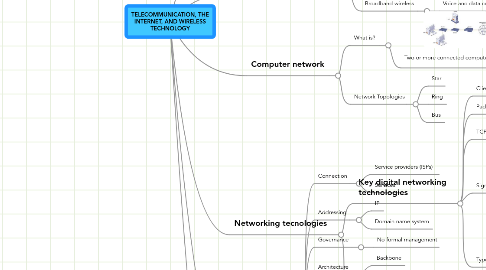
1. LEARNING OBJECTIVES
1.1. Main telecommunications transmission
1.2. Components of telecommunications
1.3. How the Internet technology work
1.4. Principal technologies and standards
1.5. Asess the value of RFID
2. Networking and communication trends
2.1. Convergence
2.1.1. Telephone networks
2.1.2. Computer networks
2.2. Broadband
2.2.1. 60% of U.S.
2.3. Broadband wireless
2.3.1. Voice and data communications
3. Computer network
3.1. What is?
3.1.1. Two or more connected computers
3.1.1.1. Simple network
3.1.1.2. Corporate network
3.2. Network Topologies
3.2.1. Star
3.2.2. Ring
3.2.3. Bus
4. Networking tecnologies
4.1. Key digital networking technologies
4.1.1. Client/server computing
4.1.2. Packet switching
4.1.3. TCP/IP and connectivity
4.1.3.1. Connectivity between computers enabled by protocols
4.1.4. Signals
4.1.4.1. Modem
4.1.4.1.1. Digital
4.1.4.1.2. Analog
4.1.5. Types of networks
4.1.5.1. LANS
4.1.5.2. CANS
4.1.5.3. WANS
4.1.5.4. MANS
4.2. Communication transmission
4.2.1. Media
4.2.1.1. Physical
4.2.1.2. Wireless
4.2.2. Speed
4.2.2.1. Hertz
4.2.2.2. Bandwidth
5. Internet
5.1. Connection
5.1.1. Service providers (ISPs)
5.1.2. Services
5.2. Addressing
5.2.1. IP
5.2.2. Domain name system
5.3. Governance
5.3.1. No formal management
5.4. Architecture
5.4.1. Backbone
5.4.2. Regional networks
5.5. Future
5.5.1. IPv6
5.5.2. Internet2
5.6. Services
5.6.1. E-mail
5.6.2. Chatting
5.6.3. Newsgroups
5.6.4. Telnet
5.6.5. FTP
5.6.6. WWW
5.6.6.1. HTML
5.6.6.2. HTTP
5.6.6.3. URLs
5.6.6.4. Web servers
5.6.6.5. Search engines
5.6.6.5.1. Case
5.6.6.6. Shopping bots
5.6.6.7. Web 2.0
5.6.6.7.1. Interactive-based services enabling people to collaborate
5.6.6.8. Web 3.0
5.6.6.8.1. Current efforts to make using Web more productive
5.6.7. VoIP
5.6.8. Unified Communications
5.6.9. VPNs
5.6.10. Intranets
5.6.11. Extranets
6. Wireless
6.1. Devices
6.1.1. PDAs
6.1.2. BlackBerry
6.1.3. Computers
6.1.4. Phones
6.1.4.1. Systems (Gs)
6.2. Access
6.2.1. Bluetooth
6.2.2. Wi-Fi
6.2.3. WiMax
6.3. Radio frequency
6.3.1. Active RFID
6.3.2. Passive RFID
6.3.3. Uses
6.3.3.1. Automated toll-collection
6.3.3.2. Tracking goods in supply chains
